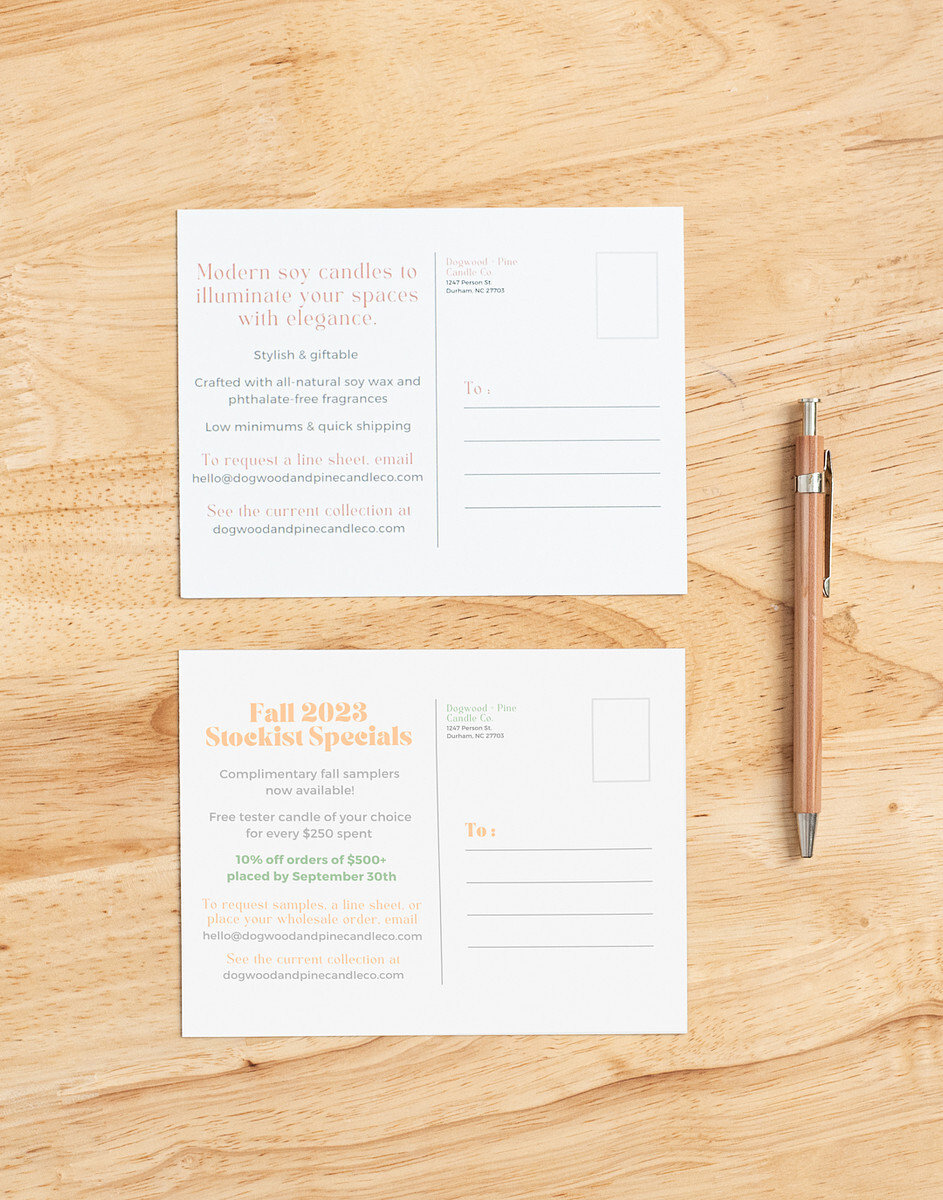How to pitch your candles to retailers Everything you need to know to build connections with shops and grow your wholesale business.

If you’re eager to expand your candle business, wholesale pitching is the strategy that puts you in the driver’s seat.
No more hoping for shops to discover you on social media or online wholesale platforms! With this approach, you take the initiative to introduce your products and foster connections with potential retailers.
In this article, we go over a range of pitching methods, from compelling emails and standout postcards, to direct phone calls and impactful in-person meetings. We offer practical tips for each and discuss the best times to pitch to increase the possibility of landing orders.
What is wholesale pitching and why does it matter?
Wholesale pitching is an outreach strategy where you proactively introduce your candles and brand to potential retail partners.
Pitching cultivates mutually beneficial partnerships with shops that result in wholesale orders.
Most pitching methods are either free or relatively low-cost compared to the expense of commissions or ads, so the investment required to pitch is minimal.
And when you grow your wholesale business, you’re able to create a stable revenue stream. Plus, having your candles in brick-and-mortar shops can lead to more brand visibility, in-turn generating additional retail sales on your website.
Methods for pitching your candles
So how exactly do you pitch your brand and products to retailers? There are four primary ways:
Email and postcard pitching are passive approaches. And you may need to reach out more than once to the shops you contact.
Phone pitching and in-person meetings are the most direct and active ways to engage with retailers, but these methods can take practice to become proficient.
To make wholesale outreach more enjoyable—and something you’ll want to do for the long term—choose the pitching methods that most closely align with your personal style and communication preferences.
Before you begin wholesale outreach
You’re more likely to experience success when pitching if you’ve spent time on these foundational aspects of your business. Make sure to:
-
Develop a clear brand identity. Know your target market and who your candles are for. And prepare an elevator pitch that succinctly shares what your brand is about and who it’s for.
-
Create a strong product line. The price point, packaging choices, and materials used in your product line convey a cohesive story that connects with your brand’s identity—and appeals to retailers and customers alike.
-
Price your products for profit. When wholesaling, the volume of sales helps offset the smaller margins. However, you still want to make sure your pricing turns enough profit to make wholesale worthwhile and sustainable in the long term.
-
Make a wholesale line sheet. A well-organized line sheet that showcases your products is a powerful tool in your wholesale arsenal. Have it ready to share when pitching so browsing is easy for interested shops.
- Identify potential retailers. Spend time researching shops to contact and make a list of candidates that are most aligned with your brand and target market.
If you’ve completed all of these tasks, then you’re ready to start pitching to retailers. If not, spend a bit more time preparing in these areas. Not only will pitching be easier, but your entire business will be better positioned for success!
Email pitching
When reaching out to shops for the first time, email is often the go-to method. Email pitching is:
-
Convenient and efficient. Emails can be written in advance and scheduled, and you can reach many potential partners.
-
Free and costs you nothing but your time. This is a huge advantage to makers and businesses with a limited budget.
- Generally accessible. If you’re more of an introvert, or the idea of starting a conversation with a stranger makes your stomach drop, email pitching lets you make your introduction more comfortably.
While email pitching has its benefits, there are a couple of challenges to consider too.
-
Limited sensory experience. Shop owners or buyers cannot experience your scented products through email pitches. Though this isn’t news to anyone already accustomed to marketing candles and soaps online, it does mean you have to get creative at capturing a shop’s attention. Having evocative descriptions and excellent-quality photos in your line sheet are a must.
- Potential for missed emails. Your emails may be overlooked, ignored, sent to a spam folder, or deleted without being read. Absent a reply from the recipient, you can’t know with certainty if your email was read. Sending follow-up emails is crucial to ensure your pitch is ultimately seen.
Crafting your email pitch
As a business owner, you’ve probably received email or direct message pitches that seem impersonal and are likely being sent en masse. How effective were they?
Sending individualized emails is much more authentic and more likely to result in a response—or, even better, an order!
The specifics of your email pitches are unique to your brand, your style, and the shops you reach out to. This means each email should be tailored to each shop you contact.
However, personalized email pitches don’t require you to start from scratch every single time. Creating a customizable template is a great way to save some time.
It’s best if the template and final pitch are relatively brief and to the point. This means a couple of succinct paragraphs that are as scannable as possible. No multi-sentence paragraphs or walls of text!
While it’s tempting to talk up your brand and line, always keep the focus on the shop and its customers. This pitch is truly about them. Your goal is to quickly pique interest and clearly demonstrate why your candles are a good fit for them so they are moved to take action.
Five tips for your email pitch
-
Greet the recipient by name. If you happen to find the names of other employees in your research, include them here too!
-
Create a connection. Pulling from your research notes, mention something specific about the shop you’re contacting to help create a connection out of the gate. Be sure to use the shop’s name.
- Example: I’ve long admired Sovrana on Instagram and hope your fifth-anniversary party last week was a big success—the floral installation your team created was stunning!
- Example: I’ve long admired Sovrana on Instagram and hope your fifth-anniversary party last week was a big success—the floral installation your team created was stunning!
-
Introduce yourself. Briefly introduce yourself and your business using your elevator pitch mentioned earlier.
- Example: My name is Hailey Johnson and I’m the founder of Esprit Home Fragrance. Esprit offers luxuriously scented cocosoy candles and room sprays in gold-accented vessels for women who appreciate beautiful design.
- Example: My name is Hailey Johnson and I’m the founder of Esprit Home Fragrance. Esprit offers luxuriously scented cocosoy candles and room sprays in gold-accented vessels for women who appreciate beautiful design.
-
Focus on the benefits your candles offer to the shop and its customers. This is a chance to mention key selling points, emphasize the giftability of your candles, and more.
- Example: Your discerning customers will appreciate the chic, trendy fragrances in the Esprit line. And the candles and sprays come in sophisticated linen boxes ready for gifting.
- Example: Your discerning customers will appreciate the chic, trendy fragrances in the Esprit line. And the candles and sprays come in sophisticated linen boxes ready for gifting.
-
Include a clear call to action. This is usually to view your attached line sheet. It can also be a call to visit a link to the line sheet, your Faire shop, or wholesale site if you have one. If you’re using links, be sure to hyperlink accordingly.
- Example: I invite you to view the collection in the attached wholesale catalog or through our Faire shop [hyperlinked to your shop].
Final tips for wholesale email pitching
In addition to the content of your email pitch, the subject line and the timing of the emails need to be thoughtfully considered.
We all know subject lines are meant to get attention. But when pitching, you also want to make sure it’s clear this is an email about a wholesale opportunity.
It can be useful to build a subject line based on an even more concise version of your elevator pitch. Using the example pitch above, a potential subject line could be: Wholesale luxury candles for the discerning woman.
Since you’re taking considerable effort to craft the most compelling pitch possible, send it at a time it’s most likely to be seen.
Shops are often busiest on weekends so aim to send your emails on Tuesdays, Wednesdays, or Thursdays. And if you’re able to time them for the morning, they’re more likely to land at the top of the shop’s inbox.


Pitching with postcards
Yes, we’re talking good old snail mail! It may seem a bit antiquated in the age of email and social media, but sending postcards to shops you want to connect with is an effective pitching tactic.
This approach offers two distinct advantages over an email introduction:
-
Visual impact. Postcards stand out! We’ll cover what to include in your postcard in a moment, but the front involves an eye-catching product photo. Since postcards don’t need to be opened, as long as a shop owner or buyer is checking their mail, your postcard will visible and will undoubtedly make them pause to take a closer look.
- Tangibility. Because they are physical objects, postcards can be immediately looked at and saved for future reference. And they can’t be thrown away, or ignored, without at least being touched by a person first—again increasing the chance they’ll be seen. While an email can be deleted without being opened, or sent to spam, a postcard will be delivered. And the likelihood that someone will at least see it is very high.
Of course, there are also a few considerations to make with postcard pitches.
-
Costs. Designing, printing, and mailing postcards isn't free. Though postcards are relatively inexpensive in the grand scheme of doing business, they do require an expenditure.
-
More work and time are involved. Between crafting a very succinct message due to the space limitations inherent to postcards, and coordinating the aforementioned design, printing, and mailing, this form of pitching can be more complicated than email pitching.
- Limited sensory experience. Like email pitching, shop owners and buyers still don’t get the full experience of your scented products through a postcard introduction. However, good photos can be quite compelling and as the saying goes, a picture is worth a thousand words!
Creating your wholesale postcard
For the purpose of introducing your brand and candles, the postcard will be two-sided. Like your line sheet, you want to make a compelling first impression and convey your brand’s vibe. The front of the postcard should include:
- A full-color lifestyle image
- Your logo
- Optional: your brand tagline, if you have one
- Optional: your website address
Meanwhile, the back of the postcard will feature a pre-printed message, space for the recipient’s name and mailing address, and your return address. The pre-printed message ideally includes:
- A succinct version of your brand pitch
- Benefits of the products to the end user
- Preferred contact information like your website, email address, and social media handles
- How to view your line sheet or where to order
If you’ve already created a general email pitch you can easily adapt that to the postcard message.
Depending on your skill level, comfort with design, and available time, you can design your own postcard or work with a designer.
We designed the postcards pictured in this article in Canva and printed them with AveryWePrint.
It’s worth noting that the more postcards you print, the lower the per-piece cost will be. So a run of 50 postcards will cost more per piece than a batch of 250. Try to strike a balance between printing enough postcards to meet your needs and fit your budget, but not printing so many in the name of getting a better per-piece price that you have more than you will be able to use.
Adhere to USPS standards to ensure your postcard is considered a postcard!
This means the postcard is:
- Rectangular in shape
- At least 3-1/2 inches tall x 5 inches long x 0.007 inch thick (think an index card)
- No more than 4-1/4 inches tall x 6 inches long x 0.016 inches thick
Meeting these standards allows you to receive the USPS First Class postcard rate, which is the cheapest rate available.
Phone pitching
Reaching out to shops by phone offers an even more direct and personal approach to promoting your candles. It’s also likely something that not many makers are doing—so it’s a way to stand out! Let’s look at the other benefits of phone pitching:
-
Low cost. Gone are the days of long-distance charges. There is little to no cost to call shops; you will only spend time with this approach.
- Bigger impact. Connecting through a conversation is impactful. You’ll receive real-time, direct feedback from the shop owner or buyer during the conversation. Plus you can meaningfully engage with shops outside your immediate area or region.
Like all of the strategies in this article, phone pitching has aspects that might preclude some makers from choosing it. They include:
-
A possible intimidation factor. Not every maker is comfortable being a salesperson or speaking on the phone with people they’ve not met before.
-
Organization and follow through. Phone pitching is best done when you set an appointment for the conversation. Pre-planning, appointment setting, and being able to call shops during their business hours are part of phone pitching.
- The need for practice. Unless chatting with people about your products comes naturally and easily to you, and you absolutely love doing it, you will likely need practice before picking up the phone. A conversation like this is most effective when you feel comfortable and at ease. If you are nervous or unsure, that is likely to come through in how you talk and what you say.
How to pitch by phone
Shop owners have busy schedules. And it’s of the utmost importance to respect their time. Calling with the expectation that you’ll be able to speak with them about your candles right away is not necessarily realistic. Instead, try this approach:
-
Email or call the shop first. Introduce yourself as a maker with a product line you’d like to present for consideration. Ask if it’s possible to schedule a phone appointment for a 5-minute chat with the person who makes the buying decisions for the shop.
-
Make an appointment. You may be directed to submit your line sheet by email. But if someone is willing to speak with you on the phone, set up an appointment for a later time.
-
Keep your pitch brief. On the call, share your pitch concisely and focus on the shop’s needs. Be prepared to ask questions and also listen. Tailor your approach to the conversational cues and respond accordingly.
- Offer samples. If the conversation goes well and there is real interest in your candles, offer to ship samples or perhaps even a full-sized product. You can gauge what seems best for each situation.
In-person pitching
Like phone pitching, in-person meetings are an opportunity to more quickly start a relationship with a retailer. This approach is best suited for shops within driving distance, or if you happen to travel to a place where an ideal shop exists.
The main benefits of in-person pitching are:
-
A full sensory experience. Shop owners and buyers can smell your products and fully experience them! In turn, you can get feedback from them in the moment. And you might even get an order before the meeting ends!
- Cost efficiency. Gas and your time are the main resources needed for this kind of pitching.
Prepare, practice with a friend or family member, and thoroughly research the shop you’re going to so that you can speak with natural ease. Being available to meet shop owners or buyers during business hours or at their convenience is another consideration.
Tips for in-person meetings
In-person meetings are best done at a time that you and the shop owner agree to. Showing up unannounced in hopes of catching the right person and pitching your candles is inadvisable. Demonstrate your professionalism by calling or emailing in advance and setting an appointment.
- Before the meeting, email the shop a copy of your line sheet or wholesale site so they can have the opportunity to get acquainted with your candles.
- Bring samples or full-sized products to the meeting to showcase your offerings. Be prepared to leave the samples or even one of the full-sized candles if it seems there is a lot of interest from the shop!


When to pitch?
Now that you’re familiar with various ways to pitch your candles, you might be wondering when exactly to pitch.
Ideally, pitches are timed so they arrive, or occur, when a shop is most likely to be interested in purchasing candles.
Let's look at when those times are.
Throughout the year
The first way to time your pitches is to simply make introductions as you discover shops that fit your brand. Pitching on an ongoing basis allows you to steadily introduce your brand, gradually building relationships with potential retailers.
It’s helpful to keep in mind that an initial introduction using this timing may require additional follow-ups depending on the time of year.
July, August, and September
Candles sell strongly in the fall and during the holiday seasons. In fact, many makers generate anywhere from 25% to more than 50% of their total revenue in these last months of the calendar year.
Prioritizing pitching in July, August, and September—when shops are most interested in stocking candles—increases the chance of receiving a yes. And since many retailers know candles are practically guaranteed to sell this time of year, they are often more open to trying new candle lines.
Pitching your candles in October and onward may occasionally result in landing a new order. But often shop owners and buyers don’t have the bandwidth to try new candle lines at this point. They’re in the throes of the busy season and are more likely to be placing reorders with makers and brands they already have a relationship with.
January and February
New year, new candles? Quite possibly!
Many retailers are flush with cash after the holiday season and are looking to replenish empty shelves and displays. This is a prime time to make introductions and follow up with shops that haven’t yet purchased from you.
New collections and products
Another ideal time to be in touch with potential retailers is when you launch a brand new collection, a seasonal collection (even if it’s unchanged from the previous year’s release), or a new product.
This is particularly true if you've already introduced your brand to a shop but haven't secured a sale yet. Since retailers often require multiple touchpoints before committing to a purchase, introducing new or seasonal offerings provides a natural reason to re-engage.
Relatedly, if you’re offering any wholesale specials like product or shipping discounts, or preferred pricing for pre-orders, that is another reason to send an email or a postcard.
Next steps for your wholesale pitching strategy
Now that you have more insight into how to pitch and when to do it, what’s next? It’s now time to decide on the pitching methods you’ll start with, set goals, and create a pitching schedule that works for you.
Play to your strengths and choose your pitching methods
Embrace the methods that resonate with your personality and strengths. Are you a wordsmith with a knack for writing compelling emails? Or do you shine when connecting face-to-face?
Whether you like the comfort of email or enjoy a live conversation, choose the pitching approaches that align with your abilities so you can pitch more confidently and effectively.
Set goals for yourself
Goals look different for every maker and business. But generally, it’s helpful to define your version of success so your efforts can be most purposeful.
Examples of pitching goals are:
- Sending a certain number of pitches in a specific time period
- Generating a minimum amount of revenue
- Landing a certain number of orders
- Aiming for a particular conversion rate of pitches sent to orders received
Create a schedule
Consistency and planning are key with wholesale pitching!
Consider making a schedule for yourself that outlines when and how you’ll reach out to potential retail partners. You’re more likely to maintain momentum and keep yourself accountable if you intentionally structure your time.
Scheduling can look like carving out time on a weekly basis to send pitches and identify possible shops to add to your outreach list; or, setting up blocks on a monthly or quarterly basis to devote to pitching.
Shops are always interested in finding new and talented makers to partner with and they want to hear from you! Keep this in mind as you begin, and continue on, your wholesale pitching journey.
Pitching is a gateway to collaboration where you’re providing shops with a solution that broadens and enhances their product offerings.
This is an exciting opportunity to build valuable and lasting relationships, grow your business, and enjoy even more success than you might have imagined!
If you’re interested in more candle and soap business content, be sure to check out our Business Guides. You’ll find in-depth articles on topics like product photography, selling online, shipping orders, and more.